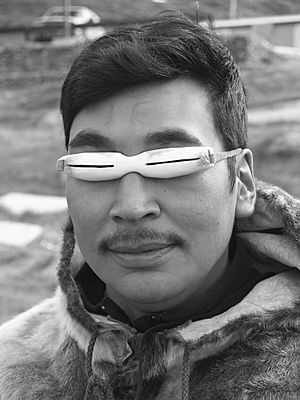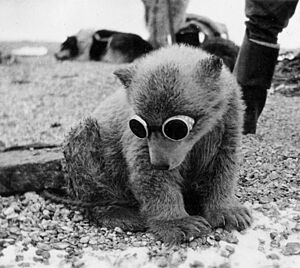Photokeratitis facts for kids
Photokeratitis is a painful eye problem. It happens when your eyes get too much ultraviolet (UV) light without enough protection. Think of it like a sunburn, but on the front part of your eye, called the cornea, and the clear covering over the white part of your eye, called the conjunctiva.
You can get photokeratitis from natural sources like bright sunlight, especially when it reflects off snow or water. You can also get it from artificial sources, like the bright light from welding. This condition has many names, including snow blindness, arc eye, or welder's flash.
The good news is that you can usually prevent this eye injury. Wearing eye protection that blocks UV rays, like welding goggles, a welder's helmet, or sunglasses with good UV protection, can help a lot. If it happens, doctors usually remove you from the UV source, cover your eyes, and give you medicine for the pain.
Contents
What Are the Signs?
If you have photokeratitis, your eyes might feel very sore. You might also have:
- Lots of tears (watery eyes).
- Your eyelids twitching a lot (this is called eyelid twitching).
- Pain or discomfort when you look at bright lights (this is called light sensitivity).
- Your pupils (the black center of your eye) might get very small (this is called constricted pupils).
What Causes It?
Any strong exposure to UV light can cause photokeratitis.
- One common cause is welding without wearing the right eye protection, like a welding helmet or special goggles. This is often called arc eye or welder's flash.
- Another common cause is snow blindness. This happens when sunlight reflects off ice and snow, especially in high places.
- Using tanning beds without proper eye protection can also lead to this condition.
Natural sources of UV light that cause photokeratitis include bright sunlight reflecting off snow or ice. It can also reflect off the sea or sand, but this is less common. Fresh snow reflects about 80% of UV light. A dry, sandy beach reflects about 15%, and sea foam reflects about 25%.
This problem is especially common in polar regions and at high altitudes. For every 300 meters (about 984 feet) you go up in elevation, the strength of UV rays increases by about four percent.
How Do Doctors Check for It?
Doctors can use a special orange dye called Fluorescein. They put it in your eye, and then look at your eye under a special light. This helps them see any damage to your cornea.
How Can You Prevent It?
You can prevent photokeratitis by wearing sunglasses or other eye protection. These glasses should let in only a small amount of visible light (5-10%) and block almost all UV rays. It's also good if they have large lenses and side shields. This helps stop light from getting in from the sides. Always wear sunglasses, even on cloudy days, because UV rays can still pass through clouds.
For thousands of years, people like the Inuit and Yupik in cold, snowy areas have made special snow goggles. They carved them from things like driftwood or caribou antlers. These goggles fit the face and have a long, thin slit cut into them. This slit lets in only a tiny bit of light, which helps prevent snow blindness. They held the goggles on with a cord made from caribou sinew.
If you don't have sunglasses, you can make emergency ones. Cut thin slits in a dark piece of fabric or tape. The SAS Survival Guide even suggests blackening the skin under your eyes with charcoal. This is like what the ancient Egyptians did. It helps stop light from reflecting into your eyes.
Explorers in Cold Places
Explorers in the Arctic and Antarctic used different ways to protect their eyes from the bright glare on the snow. Some explorers liked yellow or orange-tinted glasses. Others preferred green ones.
Robert Falcon Scott used simple goggles made from leather or wood with narrow slits. This design also helped stop frost from building up. When a Swedish expedition was shipwrecked, they made their own goggles from wood or wire frames covered with fabric from a Swedish flag.
Some people also darkened the skin around their eyes and nose. This method was used by native peoples in high mountain areas. It helped reduce the risk of snow blindness.
Even the animals on these expeditions suffered from snow blindness. Horses were given tassels over their eyes for protection. Mules were given canvas snow goggles. This shows how important it was to protect eyes in these harsh environments.
How Is It Treated?
Doctors might use special anaesthetic eye drops to numb your eye for a quick check. However, they don't use these drops for a long time. This is because numbing the eye can stop it from healing properly. It could even lead to more serious problems.
Cool, wet cloths over your eyes and artificial tears can help when the pain returns. Doctors might also give you Nonsteroidal anti-inflammatory drug (NSAID) eyedrops to help with swelling and pain. If the pain is very bad, you might get oral pain medicine.
Your eyes usually heal quickly, often within 24 to 72 hours, once you are away from the UV light source. To help your eyes heal, you should stay in a dark room. Also, take out any contact lenses, don't rub your eyes, and wear sunglasses until you feel better.
See also
- Actinic conjunctivitis
- Eye black
- Glare (vision)
- Health effects of sunlight exposure
- Light pollution
- Photic retinopathy



